Electronic video screens and displays in sport
It may seem that an electronic video screen or display is not so important for a stadium. But the history of stadium development has shown that it is not the least problem at all, especially considering the fight for the audience, advertisers or sponsors. The first stadiums equipped with large electronic video screens were ones in America and it was connected with intense fight between stadiums and TV for the spectators and fans, advertisers and sponsors.
In 1970–80 the rapid growth of cable and broadcasting TV in America has resulted in the fact that there became fewer attendants at the stadiums. It was a difficult time not only for stadiums and sports complexes, but also for cinemas. The situation was similar to what happens in Russia now. The research work has shown that one of the most significant reasons why stadiums conceded to TV channels was the lack of the opportunity to repeat interesting goals, successful spurts, attacks, other moments of games, and the TV gave such a possibility. Moreover, they could show the game from different angles and points.
So, the first stadium in Russia equipped with an electronic video screen is the one in St-Petersburg, then in Luzhniky in Moscow. We have got the information that the stadium in Kazan is being equipped now.
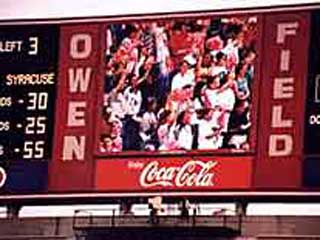 |
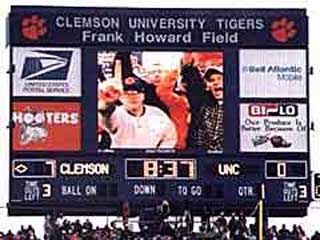 |
| Large electronic video screens at USA stadiums | |
Stadiums' owners understood this disadvantage and commenced equipment of stadiums and sports grounds in spite of the fact that the electronic video screens and displays were 3-4 times more expensive those days. Many hockey grounds in Canada & the USA have already been equipped with four electronic screen video cubes. Basketball grounds and stadiums where football matches are held are also equipped with huge electronic screens and displays.
Almost all motorcycle and car tracks, not to say a word about Formula 1, are also equipped with huge outdoor video screens. It is popular now in America to install electronic screens at smaller University, school, college stadiums.
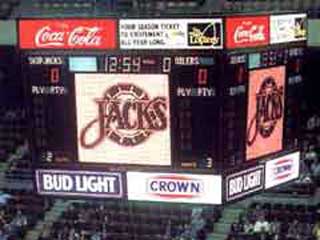 |
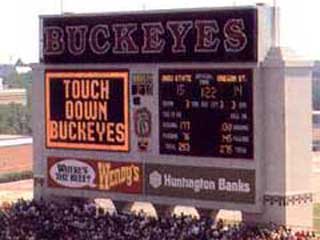 |
| Four LED screen video cube | Huge LED screen at USA stadium |
As a result:
- Fans resumed visiting stadiums.
- Matches of different rank (even international, including friendly matches) are held at the stadiums that are equipped with large electronic video screens and displays.
- Many tour agencies include visits to such stadiums (as places of interest) in their programs – that gives the cities and the stadiums extra money.
- Advertisers and sponsors are investing money more easily now because the stands are full again.
- The youth enjoys sports and goes in for sports more and more now (and there became more young stars) because they have got used to visiting stadiums with their families since childhood.
All the expenses have recouped – and many systems are now being equipped with new and more modern electronic video screens or displays. The Chinese, Korean, Japanese and South-Eastern Asian engineers keep pace with the Americans, and in some questions they applied their national peculiarities and equipped smaller sports grounds and sports resorts (not only the biggest stadiums) with huge video screens.
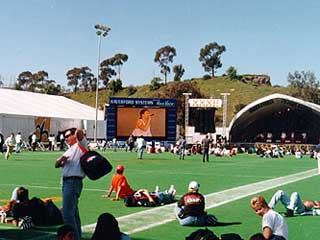 |
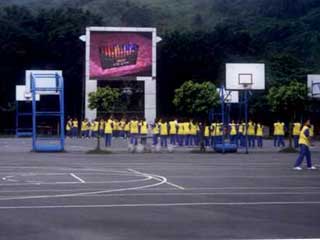 |
| Mobile LED video screen at small stadium | LED video screen at small stadium |
How to choose large video screen for sport application
First of all, you should consider the type of your stadium – open (outdoor) or closed (indoor). If it is indoor stadium, you should choose an indoor electronic screen (either a rear-projection, or a projection, or a LED video screen). If this is outdoor stadium, you should choose an outdoor LED or lamp screen. The only specific feature is that several purely informational scoreboards are used in composition for displaying the score, time, etc.
Though there are electronic displays that face the stadium during some sports events and are turned to the city (work as advertizing screens, for example, in St-Petersburg) but it is determined by the location of the stadium in the city. The usage of assembling/disassembling electronic video screen is also possible. The choice of the video screen type (for a definite screen size) – the lamp, LED, LED cluster, etc. – depends on your financial opportunities.
The largest stadiums in the world have been generally equipped with LED cluster video screens (even though they are very expensive). There are also examples of the use of lamp screens at large stadiums (40-60 thousand spectators) – in the US & the UK. At first there were CRT-based video screens installed at the stadiums (mostly in Socialist countries). Lamp screens prevail at smaller stadiums (20 000 spectators) in England and America because of their good quality and acceptable price (better than the quality of cheap LED or CRT screens).
The situation in South-Eastern Asia is a bit different: LED video screens on dot matrixes are installed at smaller stadiums (anyway they concede to cluster LED screens, but they are also much cheaper). Large LED cluster video screens are installed at the biggest stadiums.





